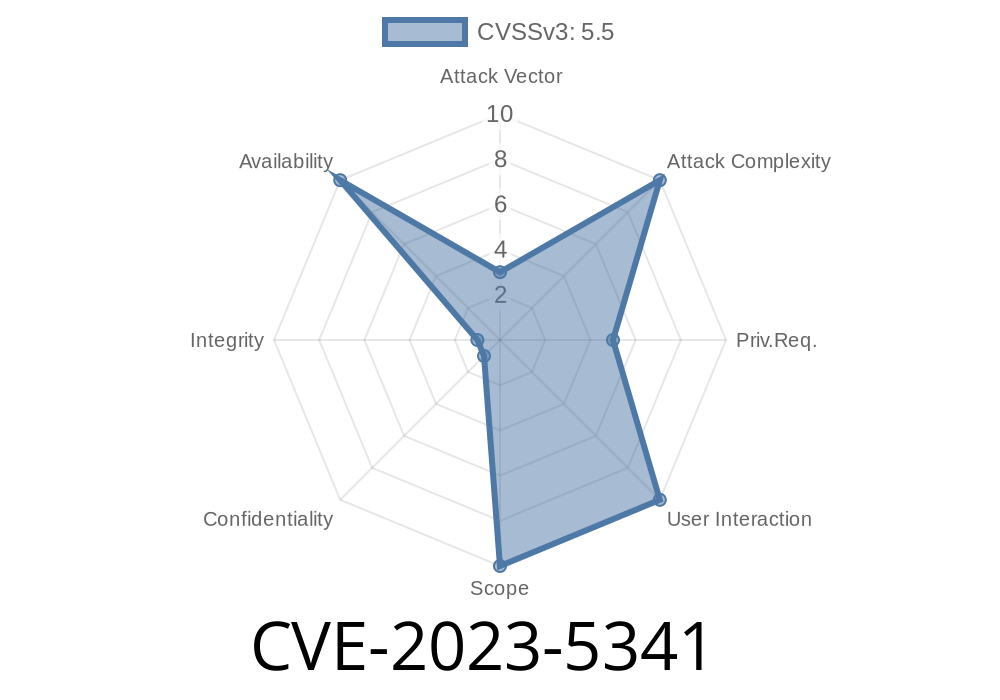Security researchers have discovered a critical heap use-after-free vulnerability in ImageMagick, an open-source software suite for displaying, converting, and editing a wide variety of image formats. The vulnerability, assigned as CVE-2023-5341, specifically impacts the coders/bmp.c source file, which is designed for handling BMP files (bitmap image files). If exploited, this vulnerability can lead to arbitrary code execution and potential denial of service attacks.
In this post, we will delve deeper into the vulnerability details, including a code snippet showcasing the source of the flaw, original references, the overall impact of the exploit, and possible mitigation strategies.
Vulnerability Details
The vulnerability in ImageMagick's coders/bmp.c file is caused by a heap use-after-free error. Heap use-after-free bugs typically occur when a program continues to use a pointer after it has been freed, leading to both information leak and memory corruption. Within coders/bmp.c, the function responsible for the vulnerability is the 'ReadBMPImage' function. The heap use-after-free issue can be triggered when an attacker submits a malicious BMP file, causing the software to crash or potentially granting the attacker the capability to execute arbitrary code.
The following code snippet highlights the vulnerable section of coders/bmp.c
while (delta_bits > )
{
ssize_t delta_bytes;
delta_bytes=(ssize_t) (delta_bits/8)+((delta_bits % 8) > ? 1 : );
for (i=; i < (ssize_t) delta_bytes; i++)
{
...
}
delta_bits-=delta_bytes*8;
}
In the above code, the 'delta_bits' variable controls the loop condition. An attacker can craft a malicious BMP file to manipulate the 'delta_bits' value, leading to an arbitrary number of loop iterations. This can cause the heap use-after-free error and eventually lead to memory corruption.
Original References
1. Official CVE-2023-5341 Listing:
2. ImageMagick GitHub Repository:
Exploit Impact
As previously mentioned, a successful exploit of the CVE-2023-5341 vulnerability can result in arbitrary code execution and potential denial of service attacks. This may enable an attacker to gain unauthorized access to a system, exfiltrate sensitive information, or disrupt the image editing and conversion process, causing significant damage to both individual users and organizations reliant on ImageMagick for media management.
Mitigation Strategies
To mitigate the risks associated with CVE-2023-5341, users are urged to apply any available patches and updates as soon as they are released by the ImageMagick development team. In the meantime, users can take the following precautionary measures to reduce the chances of a successful exploit:
1. Avoid processing untrusted BMP files: Only open, edit, and convert BMP files from trusted sources. If there is any doubt about the legitimacy of a file, refrain from using ImageMagick to process the image.
2. Use alternative file formats: If possible, use alternative image formats such as JPEG or PNG instead of BMP, especially when processing external files or user-submitted content.
3. Disable BMP support: If your use case does not require BMP support, consider disabling the functionality in ImageMagick by recompiling the software without BMP support or by adjusting configuration settings.
4. Implement strict input validation and filtering mechanisms: For web applications using ImageMagick to process user-submitted images, implement proper input validation and filtering mechanisms to ensure the integrity of submitted files.
Conclusion
CVE-2023-5341 is a critical heap use-after-free vulnerability found in ImageMagick's coders/bmp.c file. By exploiting this flaw, attackers can potentially execute arbitrary code or launch a denial of service attack. Users and administrators should apply available patches and follow the mitigation strategies outlined above to reduce the likelihood of a successful exploit.
Timeline
Published on: 11/19/2023 10:15:49 UTC
Last modified on: 12/01/2023 18:01:53 UTC
